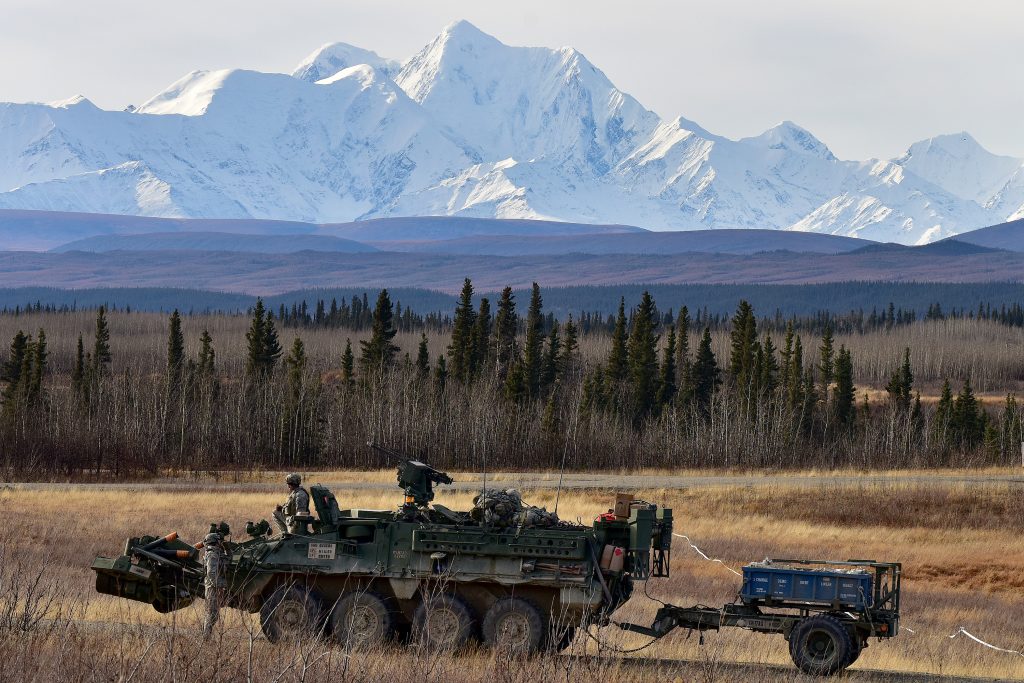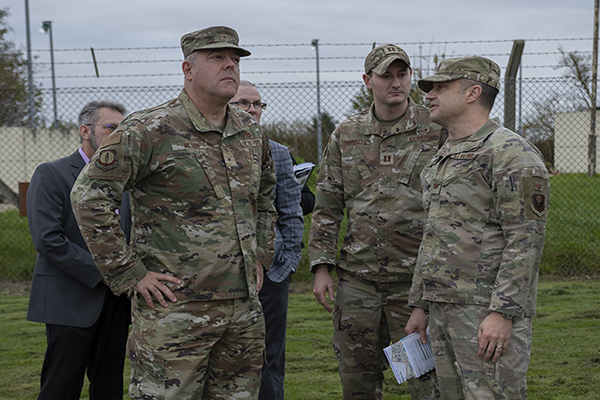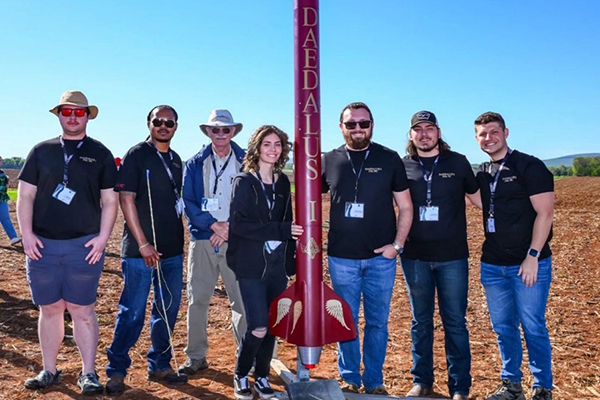By Col. Patrick Coullahan, P.E., PMP, CFM, F.SAME, USAF (Ret.)
With abundant natural resources and a critical geographic positioning, the Arctic continues to rise in importance to America’s strategic interests, requiring an ongoing evolution of military, economic, and diplomatic policy.

The Arctic is among the last remaining “final frontiers” on Earth. Comprising the northernmost geography of the globe, the Arctic holds vast natural resource potential as well as national security significance. In fact, the 2022 National Security Strategy is the latest U.S. commitment to the importance of the area with an imperative to “Maintain a Peaceful Arctic.”
Meeting this mission, however, requires a better understanding of this comparatively unchartered territory, its associated opportunities and risks, and how Arctic nations like the United States are impacted by what is an evolving geopolitical state. As Arctic activities such as drilling, mining, exploring, and military basing evolve, with physical access to the region increasing, America’s involvement and its policy approach must be continually refined to meet the changing needs.
However, its adversarial footing must be considered, with Russian operations recently including increased military infrastructure and basing, greater icebreaker capabilities, and a focus on more than just logistical and shipping investments.
Resource-Rich-Region
Because the Arctic experiences such harsh weather, exploring and mapping the region requires care and extensive planning. Building on the knowledge gained by the indigenous peoples, in the early 1700s Vitus Bering led the first organized exploration of the area where Siberia is joined near America. Other early explorers included British explorer Captain James Cook, missionaries, and miners.
In 1885, Lt. Henry Tureman Allen, USA, a West Point graduate, led a small expedition of Alaska’s formidable terrain. In only 20 weeks, his team did the unthinkable—covering 1,500-mi and mapping valleys, rivers, volcanic activity, mountains, geology, mineral wealth, and glaciers, as well as gaining an understanding of the climate and Native Alaskan culture. So much new knowledge came from this historic journey it is sometimes referred to as “Alaska’s Lewis and Clark Expedition.”

In June 1903, Lt. William Mitchell, USA, led a team that completed construction of the first telegraph line spanning Alaska’s vast interior. For the first time, military intelligence officials could transmit telegraphed messages strictly through American soil. Many years later, in 1935, he would proclaim that “Alaska is the most strategic place in the world.”
This group comprises the Arctic Council, and are joined by other participating nations: the United Kingdom, Germany, and China.
His statement would prove prescient during World War II, which saw battles in Alaska (including the brief Japanese occupation of Attu and Kiska Islands during the attack on Midway), construction of the Alaska-Canadian Highway, establishment of multiple military bases and outposts, and support of the Soviet Union with nearly 8,000 planes delivered through the Alaska-Siberian Air Route. Along with its military importance, the Arctic is also home to natural resources with importance for national security and economic interests. Geological studies by the Department of Interior have discovered significant oil and gas deposits. As mining techniques progressed over the decades, they likewise adapted to the harshness of operating in the Arctic; this opened the way to further related exploration, extraction, production, and delivery.
The greater footprint of activities in the Arctic led to further discovery of rare earth and other essential minerals, which have benefited from the mining advancements and supporting logistics.
Geopolitical View
On the global stage, the Arctic is an International Region that is formally shared by eight neighboring countries (United States, Russia, Norway, Greenland, Sweden, Finland, Canada, and Iceland). This group comprises the Arctic Council, and are joined by other participating nations: the United Kingdom, Germany, and China. The Arctic Council also includes representatives from the Aleut International Association, the Russian Association of Indigenous Peoples of the North, the Saami Council, the Arctic Athabascan Council, the Inuit Circumpolar Council, and the Gwich’in Council International.
Because the Arctic Council includes such differing strategies, interests, and sovereignty concerns, these checks and balances should inspire hope for sound policies and activities. But this collective body needs to be measured independently for sure—and that starts with understanding each nation’s ongoing investments and prospective plans for the region.

Canada. While Canada has stated that insufficient physical and social infrastructure has hindered opportunities for growth and prosperity in the region, the country has opened new mines in the Canadian Arctic and is a large employer in the mining sector. It also is planning rail extensions and port improvements in the Far North. Canada has been the scene of unprecedented wildfires with major evacuations of residents and losses of significant resources (not as devastating as recent Russian fires, but something probably not seen in 10,000 years).
Secure and Stable
An understanding of the Arctic’s acute importance to national security is certainly not new, but the emerging opportunities created by a warming climate and the consequential interests of other nations increases the urgency for attention—and U.S. investment.
Just this spring, during a forum held by the Atlantic Council in Washington, D.C., Esther McClure, Director of Arctic and Oceans Policy for the Department of Defense, detailed how the region has quickly become a leading setting of great power competition. “We are facing risks from an increasingly assertive, and even aggressive action by Russia and the People’s Republic of China,” McClure said, and “that is the most likely and most dangerous risk at the same time.”
Competition in the region has followed the opening up of sea lanes once blocked by ice, and the increased demand for rare earth minerals and other natural resources is acting as a gravitational pull.
The 2022 National Security Strategy, which emphasizes the need for efforts that promote security and stability in the region, builds on the 2019 DOD Arctic Strategy that also outlines a desired end-state of “secure and stable” in which U.S. interests are “safeguarded” as well as the National Strategy for the Arctic Region, issued in 2013, and its added focus for sustaining peace and the need for collaborating with allies and partners. The Defense Department expects to release an updated Arctic Strategy in the coming months of 2024.
Greenland. Greenland recently made public a new Arctic Strategy that seeks to create and nurture closer links between the Artic areas in North America for education, exploration, and extraction of critical minerals. Along with Iceland, Greenland wants to ensure tensions in the area are low. The emerging realism and ideals of Greenland aim to strengthen military presence and reduce mistrust by others. The nation is seeking a partnership with Japan and the potential establishment of a Peace Center in Greenland.
Russia. Russia, with roughly half the land mass in the Arctic and half the population, has always maintained a focus there. Its stated policy looking toward 2035 includes a series of interrelated, but also influential objectives: ensuring sovereignty and territorial integrity; preserving the Arctic as a region of peace with stable and mutually beneficial partnerships; guaranteeing prosperity for people of the Russian Arctic zone; developing the Russian Arctic as a strategic resource base to speed up national economic growth; developing the Northern Sea Route as a globally competitive transport corridor; and protecting the overall environment.
Russia is a prominent provider of natural gas to many European countries from its Yamal Liquid Natural Gas Plant, and is expanding natural gas operations for further export from several locations. However, its adversarial footing must be considered, with Russian operations recently including increased military infrastructure and basing, greater icebreaker capabilities, and a focus on more than just logistical and shipping investments. Russia has a sizable number of Arctic bases that have been modernized, expanded, or newly developed. The public is not knowledgeable about its missions, capabilities, and alert status.
China. Although not an Arctic nation, China has declared the region to be a part of its broader strategy for expanding its global engagement and influence. China’s description of the Arctic as a “global common” demands that the current geographically vested Arctic Nations seriously consider its intentions in the political, economic, and environmental decisions necessary to shape activities and policies. Where there is a stated intent, attention must be given.
United States. The United States shapes and enacts its military, economic, and diplomatic activities in the Arctic through a variety of federal entities and non-governmental organizations.
The Alaska District of the U.S. Army Corps of Engineers (USACE) serves as the subject matter experts in engineering and construction in the Arctic, with seven decades of experience and billions of dollars of complex construction projects completed.
- Most notably, the F-35 beddown with multiple state-of-the-art facilities at Eielson AFB has been recently wrapped up and delivered.
- The ongoing multiyear 16/34 Runway Extension at Joint Base Elmendorf Richardson will increase the proficiency and safety of delivering mission responsiveness within the Arctic Region and beyond.
- The expansion of Missile Field 4 at Fort Greely for the Ground-Based Midcourse Defense System enables the fielding of 20 ballistic missile interceptors at a location crucial to defend our nation; and the completion of the Long Range Discrimination Radar at Clear AFS and ongoing improvements to the supporting facilities and utilities are an affirmation that this site is essential to detection and tracking of missile threats.
- The Nome Port expansion will also provide a needed Arctic port and harbor that could be accessed by U.S. Navy and U.S. Coast Guard vessels in time of need.
- USACE Alaska District also maintains the Permafrost Tunnels in Alaska, which support the ability to provide better Arctic-based solutions to the problems surrounding permafrost as a result of the studies performed there.
The Army’s Cold Regions Research & Engineering Laboratory, a premier center for research in the Earth’s cold regions, has for over six decades supported the needs of the Defense Department in meeting the challenges encountered in some of Earth’s harshest and most austere cold region environments. This includes the Arctic (its forerunner agency until a 1961 merger was the Arctic Construction and Frost Effects Laboratory).
The Ted Stevens Center for Arctic Security Studies, recently established in 2021, is dedicated to embracing innovation and striving for excellence in defense education. The center conducts practitioner-relevant research and fosters collaborations with America’s Arctic security allies and partners, aiming for a positive impact to the collective well-being of the region and beyond.
The nonprofit Arctic Institute, headquartered in Washington D.C., states a mission “to help inform Arctic policy in the context of the climate crisis.” The institute follows a range of issues covering the divergent interests of the many players in the Arctic (economic, food, environmental, cultural, health, energy, political, and security), and can drive informed conversations about them.
The special problems created by the climatic, geological, and logistical conditions of the Arctic and subarctic demand knowledge and techniques not usually covered in normal engineering courses.
The University of Alaska has long offered learning about advanced Arctic engineering, logistics, and project management skills needed to effectively face the future. At the campus in Fairbanks, a focused engineering program provides training for graduate engineers who must deal with the unique challenge of design, construction, and operations in the cold regions of the world. The special problems created by the climatic, geological, and logistical conditions of the Arctic and subarctic demand knowledge and techniques not usually covered in normal engineering courses. The University of Alaska Anchorage was recently selected by the Department of Homeland Security to lead a consortium of academic institutions and other partners for a new ADAC-ARCTIC, a Center of Excellence focused on Arctic research. The goal over the next decade is to provide resources for homeland security stakeholders to advance infrastructure and operational missions in the Arctic.
The Way Ahead
As technological advances and evolving geopolitical statuses make their impact on the global landscape, the importance of the Arctic only will continue to rise—and how the United States engages with partners in the region must keep pace.
Managing this critical environment requires a confluence of military, economic, and diplomatic policy in order to ensure safety and security in the way ahead. There is not an alternative option.
Col. Patrick Coullahan, P.E., PMP, CFM, F.SAME, USAF (Ret.), is former Chief, Construction & Operations, USACE Alaska District; patrickcoullahan@gmail.com.
Article published in The Military Engineer, July-August 2024
More News from TME
-

Leading the Way: Partnering for Resiliency and Readiness
TME Interview with Brig. Gen. Patrick Miller, P.E., F.SAME, USAF Commander, Air Force Civil Engineer Center -

Developing Tomorrow’s STEM Workforce Through Partnership
TME recently interviewed leaders of the Panama City Post about paying it forward, their repertoire of STEM outreach, and the benefits of collaborating with similar-minded professional organizations. -

Electrifying Solutions for Military Installations
As military installations implement electrification measures into the future, the challenges they face will not just require innovative technology solutions but embracing a holistic delivery approach implemented early in projects.